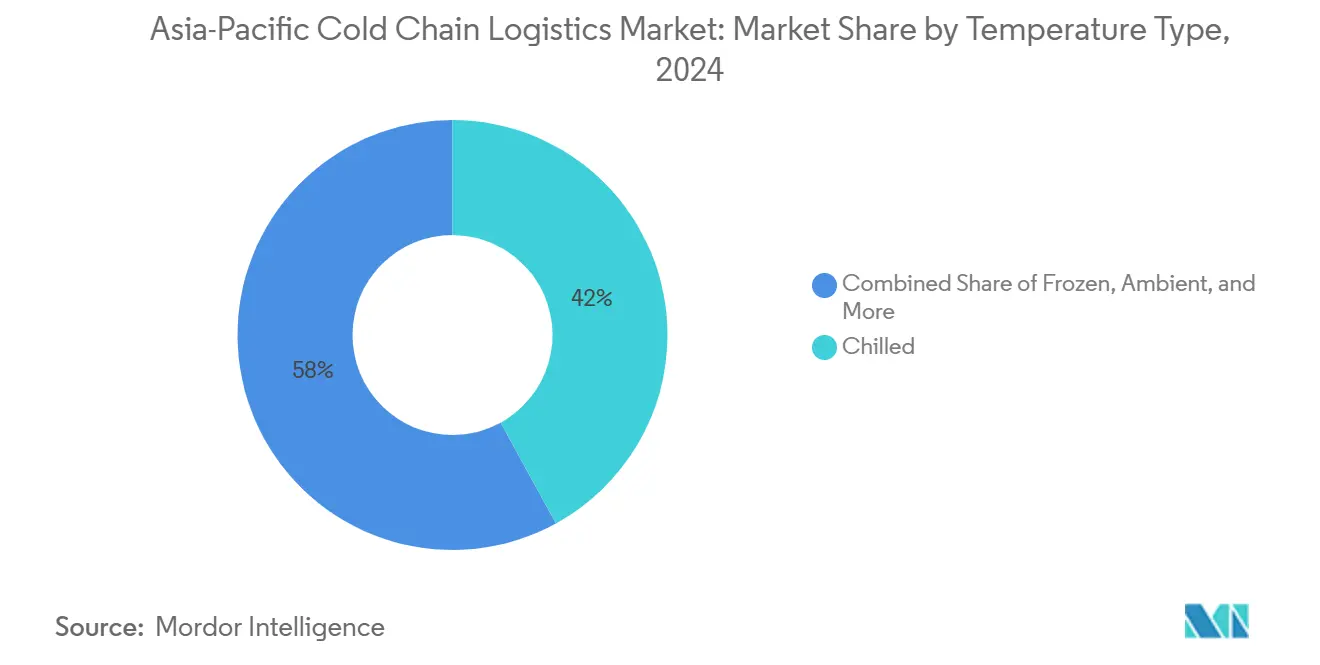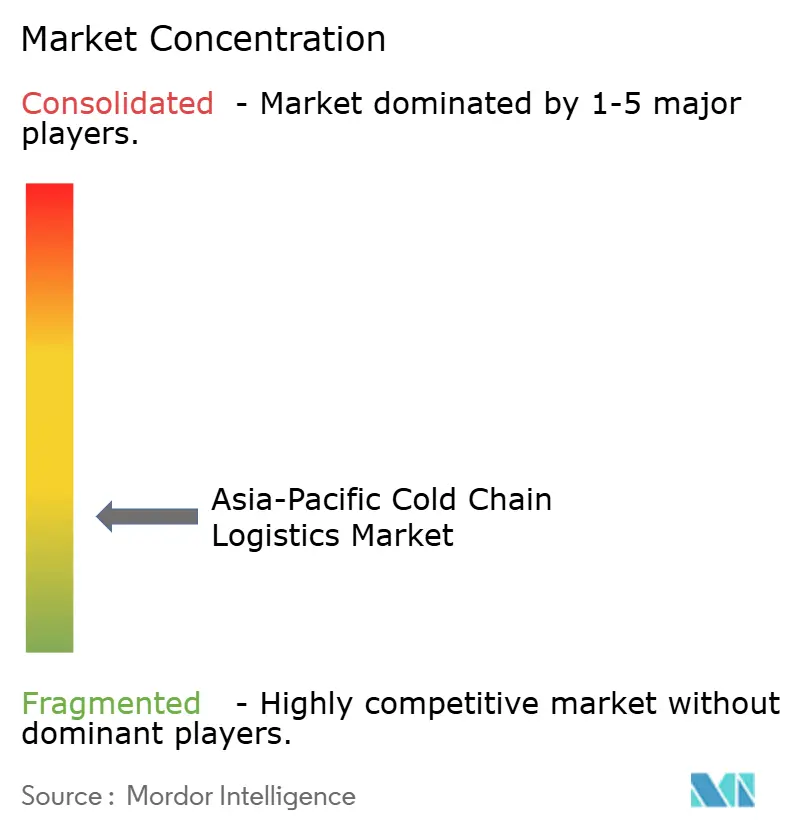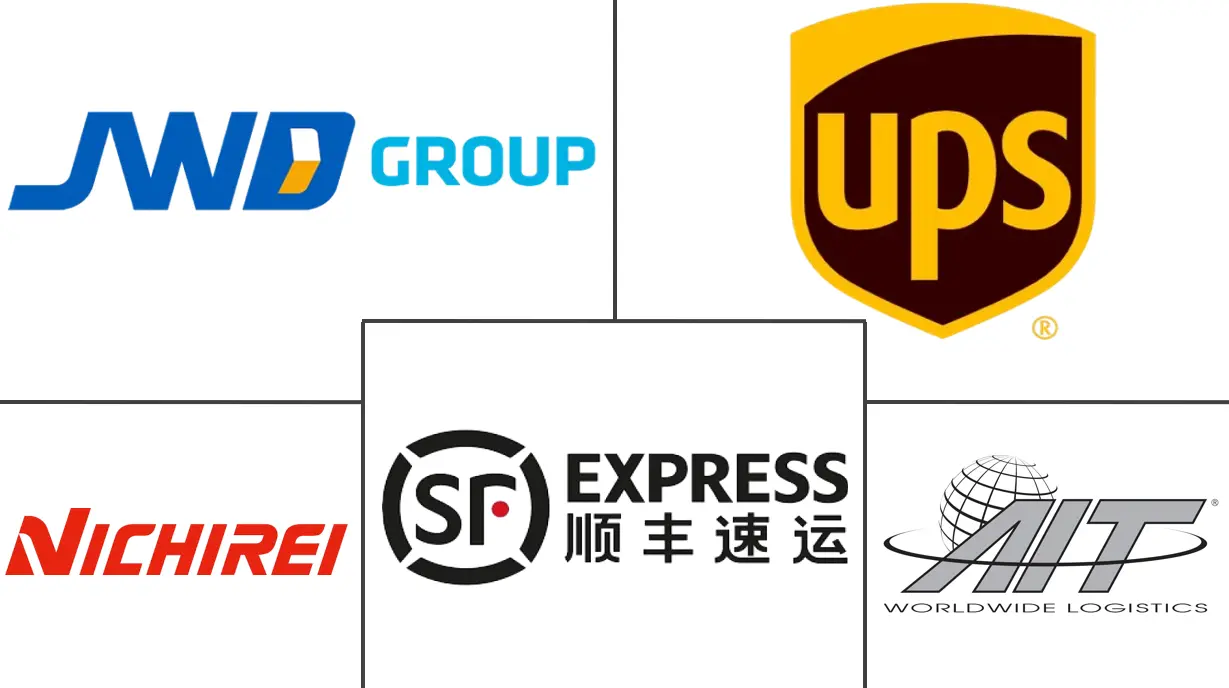
Asia-Pacific Cold Chain Logistics Market Analysis by Mordor Intelligence
The Asia-Pacific Cold Chain Logistics Market size is estimated at USD 145.07 billion in 2025, and is expected to reach USD 181.55 billion by 2030, at a CAGR of 4.59% during the forecast period (2025-2030).
Rising disposable incomes, rapid e-grocery penetration, and pharmaceutical supply-chain upgrades keep demand on a steady upward course even as overall warehouse builds move from hyper-expansion to disciplined, technology-led optimization. China retains scale leadership, yet India’s faster build-out of distributed depots signals a decisive pivot toward proximity-based networks designed for same-day fulfillment. Operators embed AI, robotics, and natural-refrigerant systems to compress energy intensity and labor exposure, turning operational excellence into the new growth lever for the Asia-Pacific cold chain logistics market. Competition remains moderately fragmented; global consolidators accelerate M&A to secure tech capabilities while regional specialists leverage hard-won local permits and first-mile know-how to guard niche positions.
Key Report Takeaways
- By service type, refrigerated storage held 41% of the Asia-Pacific cold chain logistics market share in 2024; value-added services are projected to expand at a 4.80% CAGR to 2030.
- By temperature type, chilled applications contributed 42% of the Asia-Pacific cold chain logistics market size in 2024, whereas frozen lanes are advancing at a 4.10% CAGR through 2030.
- By application, meat & poultry led with 22% revenue share in 2024, while vaccines & clinical-trial materials are growing fastest at a 5.40% CAGR to 2030.
- By geography, China commanded 36% of 2024 value, whereas India posts the quickest 5.30% CAGR through 2030.
Asia-Pacific Cold Chain Logistics Market Trends and Insights
Drivers Impact Analysis
| Driver | (~) % Impact on CAGR Forecast | Geographic Relevance | Impact Timeline |
|---|---|---|---|
| Rising consumption of processed & frozen foods | +1.20% | Core Asia-Pacific & emerging markets | Medium term (2-4 years) |
| Growth in e-commerce grocery delivery | +1.00% | Urban China, India, SE Asia | Short term (≤ 2 years) |
| Expansion of pharmaceutical cold chain | +0.90% | India, China, Japan | Long term (≥ 4 years) |
| Harmonised SPS e-certification & paperless customs | +0.60% | ASEAN core, wider Asia-Pacific | Medium term (2-4 years) |
| Retailer-led captive cold warehousing | +0.50% | China, India, Australia | Medium term (2-4 years) |
| Multilateral infrastructure corridors | +0.40% | Belt & Road states | Long term (≥ 4 years) |
| Source: Mordor Intelligence | |||
Rising Consumption of Processed & Frozen Foods
Asia’s middle-income households increasingly favor quick-prep meals, frozen seafood, and multi-day protein packs, creating a durable core of throughput for the Asia-Pacific cold chain logistics market. Supermarket chains respond by shifting stock-keeping units toward frozen entrées and par-baked dough that demand precise -18 °C handling from plant to shelf. Facility owners retrofit high-bay zones with automatic shuttle systems to segregate chilled, frozen, and deep-frozen pallets, trimming travel time and energy loss[1]Cold Chain Federation, “Optimizing Temperature-Controlled Distribution,” coldchainfederation.org.uk. Smart labels record time-temperature curves, letting retailers cull at-risk lots before display, which reduces write-offs and tightens food-safety compliance. Urban family sizes continue to shrink, spurring purchases of portioned packs that cycle through storage networks faster, raising pallet-turn velocity and amplifying revenue per cubic meter.
Growth in E-Commerce Grocery Delivery
Instant delivery platforms pledge 15- to 30-minute drop-offs, propelling a new generation of micro-fulfillment “dark” stores furnished with modular coolers. Energy-saving variable-speed compressors paired with AI-driven HVAC trim power draw by 30% while preserving tight ±0.5 °C bands. Hybrid passive-active gel-pack boxes allow ice-cream to survive scooter rides across humid Bangkok afternoons, and IoT monitors feed data to consumer apps, turning temperature transparency into a trust signal. As grocery apps expand into Tier-2 cities, demand shifts from mega-warehouses on city fringes to spoke depots embedded in densely populated suburbs, broadening the Asia-Pacific cold chain logistics market footprint.
Expansion of Pharmaceutical Cold Chain
Clinical pipelines for biologics, cell therapies, and mRNA vaccines necessitate −20 °C, −80 °C, and even cryogenic storage alternatives, carving out a premium subsector inside the Asia-Pacific cold chain logistics market. DHL’s EUR 2 billion network upgrade boosts GDP-certified capacity, while local firms race to install vapor-phase liquid-nitrogen freezers for CAR-T cells. Regulators in India and Japan increasingly mandate electronic temperature-excursion reporting within four hours, pushing operators to adopt cloud-connected probes and blockchain audit trails. Decentralized therapy models place compact ultra-low depots adjacent to hospitals, shortening vein-to-vein cycles and lifting demand for short-haul validated containers that safeguard dry-ice levels for 72-hour windows.
Harmonised SPS e-Certification & Paperless Customs Integration
ASEAN nations accelerate electronic sanitary-phytosanitary certificates that auto-populate customs declarations, slicing border dwell times for perishable loads by 30 hours on average[2]ASEAN, “Digital Economy Framework,” asean.org. RCEP implementation brings zero-tariff coverage to 90% of agri-food trade, prodding exporters to scale temperature-controlled flows into new tariff-free corridors. Blockchain pilots on pork shipments from Thailand to China create immutable ledgers of sensor data and inspection stamps, smoothing quarantine clearances on arrival.
Restraints Impact Analysis
| Restraint | (~) % Impact on CAGR Forecast | Geographic Relevance | Impact Timeline |
|---|---|---|---|
| High energy & real-estate cost of cold facilities | -1.1% | Japan, Australia, urban China | Short term (≤ 2 years) |
| Rural first-mile infrastructure gaps | -0.8% | India, Indonesia, Philippines | Long term (≥ 4 years) |
| Shortage of low-GWP refrigerant engineers | -0.5% | Developed Asia-Pacific | Medium term (2-4 years) |
| Divergent ESG disclosure burdens | -0.3% | Multinationals | Medium term (2-4 years) |
| Source: Mordor Intelligence | |||
High Energy & Real-Estate Cost of Cold Facilities
Electricity often represents 70% of opex, and data-center demand crowds grids across Tokyo and Sydney, driving tariff spikes that erode warehouse margins. Solar-panel retrofits cut bills 25% but entail high capex and lengthy permitting, restricting adoption to larger rooftops or greenfield projects. In parallel, land prices within 10 km of CBDs climb steeply, forcing developers outward where cheaper plots lengthen final-mile legs and elevate fuel spend. Energy-efficient insulation panels and variable-capacity compressors partially offset power hikes, but payback stretches past five years, complicating ROI math for smaller operators.
Rural First-Mile Infrastructure Gaps
Inadequate grid coverage and bumpy feeder roads lift post-harvest losses for mangoes, bananas, and fish in Mindanao and Sulawesi by up to 40%[3]Philippine News Agency, “Government Eyes Cold Storage Facilities,” pna.gov.ph. Solar-driven portable cold rooms piloted in Northeast India slash spoilage but require micro-finance packages and technician support to scale. Government grants fund communal depots, yet without reliable reefer trucks to move produce onward, utilization lags. These bottlenecks cap rural throughput and temper revenue diversity for the Asia-Pacific cold chain logistics market over the long haul.
Segment Analysis
By Service Type: Integrated Value-Added Solutions Redefine Scope
Refrigerated storage contributed 41% to the Asia-Pacific cold chain logistics market in 2024. Modern high-bay freezers now rise 40 meters, using shuttle robots to pull pallets in under 60 seconds, halving manual labor and maintaining chamber integrity. Operators invest in predictive maintenance software that monitors compressor vibration and coolant pressure, cutting unplanned downtime by 15%.
Value-added services, though smaller, capture the strongest 4.80% CAGR as brand owners outsource repackaging, blast-freezing, and product conditioning to a single 3PL. Service bundling reduces handoffs, thereby minimizing temperature excursions and liability disputes. Public warehouses embrace flexible slot-pricing based on dwell time and temperature band, appealing to SME food exporters eyeing sporadic shipments. Conversely, private dedicated sites attract vaccine manufacturers that demand validated layouts and 24/7 audit access. The shift from siloed warehousing to turnkey solutions underscores how the Asia-Pacific cold chain logistics market pivots toward holistic supply-chain orchestration.

Note: Segment shares of all individual segments available upon report purchase
By Temperature Type: Frozen Momentum Adds Complexity
Chilled lanes, centered on 0–5 °C, supplied 42% of 2024 turnover, servicing dairy, fresh fruit, and ready-to-cook meals. They remain critical for urban convenience stores that cycle stock daily. Frozen loads grow at 4.10% CAGR, lifted by seafood exports, dumpling multipacks, and bakery items. Operators deploy cascade systems using R744/R717 that drive coefficient-of-performance gains, trimming energy per pallet. Natural refrigerant uptake in China’s commercial fridges hit 60% in 2024, signaling mainstream acceptance and boosting the Asia-Pacific cold chain logistics market share held by eco-compliant assets[4]Natural Refrigerants, “China’s Light Commercial Refrigeration at 60% R290,” naturalrefrigerants.com.
Deep-frozen and ultra-low chambers below −40 °C, though niche, see double-digit volume growth as gene therapy trials proliferate. These zones necessitate redundant power, vapor-lock doors, and oxygen sensors to manage CO₂ buildup from dry-ice sublimation. Ambient-controlled rooms (15–25 °C) host chocolate and specialty chemicals, acting as bridge categories that smooth seasonal swings in chilled or frozen utilization. Multi-temperature “warehouse-within-warehouse” layouts allow operators to toggle zones as product mix shifts, heightening asset flexibility and revenue resilience across the Asia-Pacific cold chain logistics market.

Note: Segment shares of all individual segments available upon report purchase
By Application: Pharma Surges Beside Core Food Streams
Meat & poultry retained 22% of 2024 receipts, underpinned by China’s pork imports and Southeast Asian chicken consumption. Bio-security concerns push processors to vacuum-seal cuts, extending shelf life but demanding precise vacuum chilling. Vaccines & clinical-trial materials grow at 5.40% CAGR, turning pharma into a marquee margin driver: validated packaging kits, lane conditioning, and 24/7 NOC oversight are priced at a premium that triples gross-profit margins versus frozen shrimp loads.
Fruit & vegetable flows leverage micro-fulfillment hubs with rapid air-blast tunnels to pull field heat within four hours of harvest, curbing shrink by 25%. Dairy & frozen desserts ride higher income levels; local brands introduce premium gelato lines requiring blast-freeze tunnels and sub-25 °C trucks. Ready-to-eat meals capture city dwellers, using retort pouches and MAP trays that tolerate longer transport; 3PLs respond by fitting cargo vans with dual-evaporator units for hot-and-cold split loads. Fish & seafood operators test slurry-ice vats aboard trawlers, preserving texture before cargo even reaches ports, a practice now embedded in SOPs for export certification. Specialty chemicals, although small, demand strict 2–8 °C bands to avoid polymerization, adding a reliable niche to the Asia-Pacific cold chain logistics market size calculus.
Geography Analysis
China’s dominant 36% share derives from long-standing industrial scale and sophisticated e-commerce ecosystems. Provincial grants subsidize low-GWP retrofits, enabling older depots to phase out HFCs without crippling cash flow. Inland western regions, once underserved, now benefit from cold-chain railcars attached to passenger high-speed trains, shrinking fruit transit times from Xinjiang to Beijing to 20 hours. Yet power-tariff uncertainty and stricter refrigerant rules impose CAPEX burdens, nudging state-owned firms toward JV partnerships with tech specialists.
India logs the Asia-Pacific cold chain logistics market’s fastest national expansion. Government viability gap funding covers 35% of cold-store capex, catalyzing private entry into Tier-2 cities such as Lucknow and Coimbatore. Ice-battery reefers extend chilled life without diesel gensets, curbing emissions and meeting Delhi’s anti-pollution mandates. ULIP’s single-window digital corridor gives growers SMS visibility of truck ETA, reducing on-dock wait times and spoilage. However, interstate permit inconsistencies linger, requiring 3PLs to maintain compliance desks that navigate evolving zoning caps and tax rebates.
Competitive Landscape
The Asia-Pacific cold chain logistics market hosts a blend of global majors—Lineage, DHL, UPS Healthcare, CEVA—and regionally entrenched firms such as Nichirei Logistics, SF Express, Kerry Logistics, Linfox, and Snowman Logistics. Lineage’s USD 4.4 billion IPO (2024) arms it with an expansion war-chest, manifested in the USD 223 million ColdPoint buy-out that deepens frozen capacity in Southeast Asia. DHL positions itself as a pharma specialist via GDP hubs, while CEVA’s AI-driven HVAC solutions court e-grocery clients seeking energy savings.
Regional champions deploy local insight and licensing agility. Nichirei bundles design-build services for Japanese fish processors; SF Express knits refrigerated last-mile bikes into its courier grid, lowering final-drop fees. Kerry Logistics uses inland China rail spurs to tap agrarian hinterlands, and Linfox leans on mine-to-port contracts in Australia that supply steady baseline volumes. White-space prospects center on rural first-mile consolidation and ESG-certified fleets; players able to link farmer co-ops to export corridors will gain stickier revenue.
Technology partnerships are pivotal: robotics firms supply −25 °C-rated pick arms, SaaS vendors deliver predictive compressor analytics, and fintech start-ups finance solar rooftop retrofits. As compliance costs rise, scale confers advantage; expect further consolidation, especially among mid-tier operators lacking capital to modernize, a dynamic that will reshape competitive contours of the Asia-Pacific cold chain logistics market.
Asia-Pacific Cold Chain Logistics Industry Leaders
-
United Parcel Service (UPS)
-
JWD Group
-
Nichirei Logistics Group Inc
-
SF Express
-
AIT Worldwide Logistics Inc
- *Disclaimer: Major Players sorted in no particular order



Recent Industry Developments
- June 2025: UPS Healthcare doubled Singapore capacity via an 11,500 m² site featuring −20 °C walk-in freezers and conveyor-linked pick modules.
- April 2025: CEVA Logistics certified new GDP/GMP sites across China, Malaysia, Singapore, and Australia, raising its Asia-Pacific healthcare headcount to 25,000.
- April 2025: DHL Group pledged EUR 2 billion (USD 2.08 billion) for global life-sciences logistics, allocating EUR 500 million (USD 520 million) to Asia-Pacific cold chain infrastructure upgrades.
- December 2024: Linfox International opened a 19,000 m² multi-temperature warehouse in Thailand with 28,000 pallet slots and 34 docks.
Asia-Pacific Cold Chain Logistics Market Report Scope
Cold chain logistics transport temperature-controlled products, such as temperature-sensitive foods, equipment, and biopharmaceutical products. The report covers the complete background analysis of the Asia-Pacific Cold Chain Logistics Market, including the assessment of the economy and contribution of sectors in the economy, market overview, market size estimation for key segments, emerging trends in the market segments, market dynamics, and geographical trends, and COVID-19 impact.
The Asia-Pacific Cold Chain Logistics Market is segmented By Services (Storage, Transportation, and Value-added Services (Blast Freezing, Labeling, Inventory Management, Etc.)), By Temperature Type (Chilled, and Frozen), By Application (Horticulture (Fresh Fruits and Vegetables), Dairy Products (Milk, Ice-cream, Butter, Etc.), Meats, Fish & Poultry, Processed Food Products, Pharma, Life Sciences, & Chemicals, and Other Applications), and By Country (China, Japan, India, South Korea, Indonesia, Thailand, Australia, Philippines, and Rest of Asia-Pacific). The report offers the market size and forecasts in terms of value (USD billion) for all the above segments.
| Refrigerated Storage | Public Warehousing |
| Private Warehousing | |
| Refrigerated Transportation | Road |
| Rail | |
| Sea | |
| Air | |
| Value-Added Services |
| Chilled (0–5 °C) |
| Frozen (-18–0 °C) |
| Ambient |
| Deep-Frozen / Ultra-Low (less than-20 °C) |
| Fruits & Vegetables |
| Meat & Poultry |
| Fish & Seafood |
| Dairy & Frozen Desserts |
| Bakery & Confectionery |
| Ready-to-Eat Meals |
| Pharmaceuticals & Biologics |
| Vaccines & Clinical Trial Materials |
| Chemicals & Specialty Materials |
| Other Perishables |
| China |
| Japan |
| India |
| South Korea |
| Indonesia |
| Thailand |
| Australia |
| Singapore |
| Malaysia |
| Rest of Asia-Pacific |
| By Service Type | Refrigerated Storage | Public Warehousing |
| Private Warehousing | ||
| Refrigerated Transportation | Road | |
| Rail | ||
| Sea | ||
| Air | ||
| Value-Added Services | ||
| By Temperature Type | Chilled (0–5 °C) | |
| Frozen (-18–0 °C) | ||
| Ambient | ||
| Deep-Frozen / Ultra-Low (less than-20 °C) | ||
| By Application | Fruits & Vegetables | |
| Meat & Poultry | ||
| Fish & Seafood | ||
| Dairy & Frozen Desserts | ||
| Bakery & Confectionery | ||
| Ready-to-Eat Meals | ||
| Pharmaceuticals & Biologics | ||
| Vaccines & Clinical Trial Materials | ||
| Chemicals & Specialty Materials | ||
| Other Perishables | ||
| By Country | China | |
| Japan | ||
| India | ||
| South Korea | ||
| Indonesia | ||
| Thailand | ||
| Australia | ||
| Singapore | ||
| Malaysia | ||
| Rest of Asia-Pacific | ||


Key Questions Answered in the Report
How big is the Asia-Pacific cold chain logistics market in 2025?
It is valued at USD 145.07 billion, with projections reaching USD 181.55 billion by 2030.
Which service segment is expanding fastest?
Value-added services, covering processing and repack, are forecast to grow at a 4.80% CAGR through 2030.
Why are frozen lanes gaining momentum?
Shifting consumer preference toward convenience foods and seafood exports is driving a 4.10% CAGR in frozen logistics.
What drives pharmaceutical cold chain demand?
Biologics, cell therapies, and vaccine programs require ultra-low temperature storage, powering a 5.40% CAGR for vaccine & clinical-trial materials.
Which country shows the highest growth rate?
India leads with a projected 5.30% CAGR, supported by infrastructure funding and digital logistics platforms.
What is the main operational cost challenge?
High electricity tariffs now represent up to 70% of warehouse opex, pressuring margins across the region.
Page last updated on:








